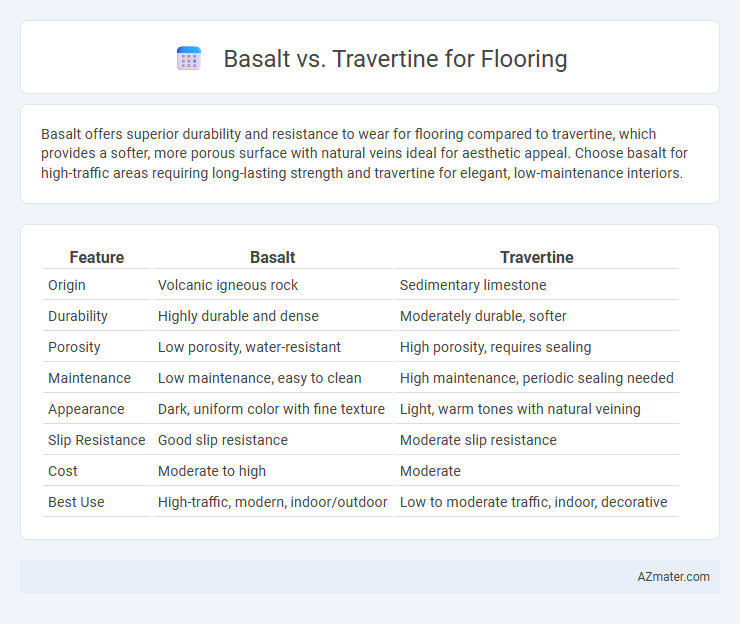Basalt offers superior durability and resistance to wear for flooring compared to travertine, which provides a softer, more porous surface with natural veins ideal for aesthetic appeal. Choose basalt for high-traffic areas requiring long-lasting strength and travertine for elegant, low-maintenance interiors.
Table of Comparison
| Feature | Basalt | Travertine |
|---|---|---|
| Origin | Volcanic igneous rock | Sedimentary limestone |
| Durability | Highly durable and dense | Moderately durable, softer |
| Porosity | Low porosity, water-resistant | High porosity, requires sealing |
| Maintenance | Low maintenance, easy to clean | High maintenance, periodic sealing needed |
| Appearance | Dark, uniform color with fine texture | Light, warm tones with natural veining |
| Slip Resistance | Good slip resistance | Moderate slip resistance |
| Cost | Moderate to high | Moderate |
| Best Use | High-traffic, modern, indoor/outdoor | Low to moderate traffic, indoor, decorative |
Introduction to Basalt and Travertine Flooring
Basalt flooring offers exceptional durability and a sleek, modern appearance due to its volcanic origin and fine-grained texture, making it ideal for high-traffic areas. Travertine flooring showcases natural elegance with its porous surface and warm, earthy tones derived from limestone deposits, providing a timeless aesthetic suitable for both traditional and contemporary spaces. Both materials are valued for their unique textures and strong resistance to wear, making them popular choices in residential and commercial flooring applications.
Key Characteristics of Basalt Flooring
Basalt flooring is renowned for its exceptional durability, dense structure, and resistance to abrasion, making it ideal for high-traffic areas. Its naturally dark gray to black coloration with subtle textural variations offers a sleek, modern aesthetic distinct from the lighter, porous travertine. Basalt's low porosity ensures minimal water absorption and easy maintenance, contrasting with travertine's more porous surface that often requires sealing and careful upkeep.
Key Characteristics of Travertine Flooring
Travertine flooring features a porous, textured surface that adds natural warmth and earthy tones to interiors, making it ideal for rustic and Mediterranean-style spaces. This sedimentary stone offers durability comparable to marble but requires sealing to prevent staining and moisture absorption. Its unique veining patterns and variations in color enhance visual interest, while the stone's ability to stay cool underfoot makes it perfect for warm climates.
Aesthetic Differences: Appearance and Color
Basalt flooring offers a sleek, modern look with its deep, rich black or dark grey hues and subtle texture, creating a sophisticated ambiance. Travertine, by contrast, showcases warm, earthy tones such as beige, cream, and tan with natural veining and pitted surface patterns that bring a rustic, classic charm. The choice between basalt and travertine greatly influences the overall aesthetic, with basalt emphasizing contemporary minimalism and travertine enhancing a timeless, organic feel.
Durability and Strength Comparison
Basalt flooring offers superior durability and high compressive strength, making it resistant to heavy foot traffic, scratches, and wear over time. Travertine, while aesthetically pleasing with its porous texture, is softer and more prone to chipping, scratching, and staining without proper sealing. For long-lasting performance in high-traffic areas, basalt is the preferred choice due to its dense, volcanic origin and robustness.
Maintenance and Cleaning Requirements
Basalt flooring requires minimal maintenance due to its dense, non-porous surface that resists stains and moisture, making it ideal for high-traffic areas. Travertine, being a porous natural stone, demands regular sealing to prevent staining and water absorption, with gentle cleaning methods preferred to avoid surface erosion. Both stones benefit from pH-neutral cleaners, but basalt's durability ensures easier long-term upkeep compared to the more delicate travertine.
Indoor vs Outdoor Suitability
Basalt offers exceptional durability and slip resistance, making it ideal for outdoor flooring in high-traffic or wet areas, while its dense, fine-grained texture provides a sleek indoor option. Travertine's natural pores and warm tones enhance indoor spaces with a classic look but require sealing for outdoor use to prevent weathering and staining. Both stones excel indoors, though basalt's toughness suits patios and walkways better, whereas travertine is preferred for living rooms and bathrooms due to its softer, elegant appearance.
Cost and Installation Factors
Basalt flooring generally costs more than travertine due to its density and extraction complexity, with prices ranging from $15 to $25 per square foot compared to travertine's $10 to $20. Installation of basalt requires specialized cutting tools because of its hardness, increasing labor costs, while travertine's softer texture allows easier shaping and faster installation. Travertine also needs sealing to prevent stains and damage, adding to ongoing maintenance expenses, whereas basalt typically offers higher durability and lower upkeep.
Environmental Impact and Sustainability
Basalt flooring offers a highly sustainable option due to its abundant natural availability and minimal processing requirements, resulting in a lower carbon footprint compared to many other stone materials. Travertine, while also natural and durable, involves more intensive quarrying and chemical treatment processes that can lead to greater environmental degradation and higher energy consumption. Choosing basalt supports eco-friendly construction by reducing resource extraction impacts and promoting longevity with less maintenance.
Choosing the Right Stone for Your Space
Basalt offers a dense, durable surface with a sleek, dark appearance ideal for high-traffic areas and modern design, while travertine features a porous texture with warm, earthy tones suitable for creating a softer, Mediterranean-inspired ambiance. Basalt's resistance to stains and scratches makes it perfect for kitchens and commercial spaces, whereas travertine requires sealing and is better suited for low-moisture environments like living rooms or covered patios. Choosing between basalt and travertine depends on balancing durability needs with aesthetic preferences and the maintenance level you can accommodate.

Infographic: Basalt vs Travertine for Flooring
 azmater.com
azmater.com